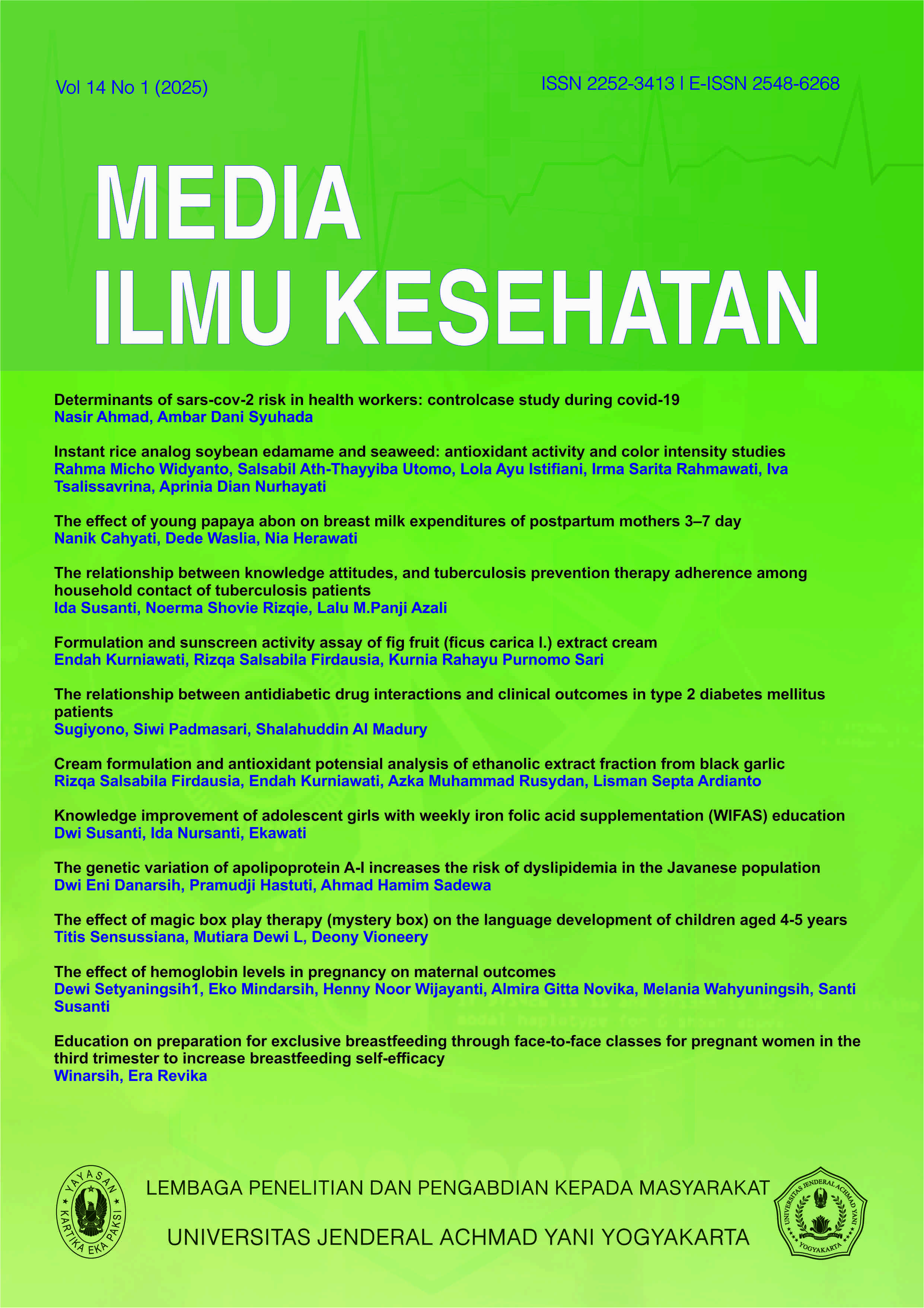The effect of magic box play therapy (mystery box) on the language development of children aged 4-5 years
DOI:
https://doi.org/10.30989/mik.v14i1.1485Keywords:
development, magic box, preschoolAbstract
Background: The golden age stage of children is at the age of 5 years. One of the games that can stimulate language skill’s children's development is playing magic box. Playing with this magic box play therapy can stimulate other aspects of development.
Objective: The purpose of this study was to determine the effect of magic box games on the language development of children aged 4-5 years at KB-TK Taruna Prima.
Methods: This research method uses quantitative methods with pre-experiment with one group pre and post test design. Total population 53 students with total sampling. Play activities are carried out twice a week fo1 1 week.
Results: The result of this study is that magic box play therapy is effective on the language development of children aged 4-5 years at KB-TK Taruna Prima, as evidenced by statistical tests showing p value <0.000.
Conclusion: Teacher can do magic box play therapy to stimulate child development. Educational institutions develop media to stimulate child development with magic box play therapy.
References
1. Ulfadhilah K, Nurlaela, Sukiman. Implementasi Kurikulum 2013 (Terpadu) di Ra Baiturrahman Bima Cirebon. Pendidik Anak Usia Dini (Pratama Widya). 2021;6.
2. Baharudin NA, Sifaq A. Pengaruh Permainan Lempar Tangkap Bola Kasti terhadap Perkembangan Motorik pada Anak Down Syndrome. J Ilmu Olahraga. 2022;2.
3. Sriwahyuni, Sulastri, I.Patabang. Efektivitas Pemberian Alat Permainan Edukatif Origami Terhadap Perkembangan Motorik Halus Anak Di TK Frater Bakti Luhur Makassar. J Ilmu Kesehat. 2020;9.
4. Nursalam. Metodologi Penelitian Ilmu Keperawatan : Pendekatan Praktis. 2015.
5. Rahmi P. Peran Nutrisi Bagi Tumbuh dan Kembang Anak Usia Dini. J Pendidik Anak. 2019;5.
6. Elizabeth B Hurlock. Psikologi Perkembangan: Suatu Pendekatan Sepanjang Rentang Kehidupan. Vol. 5, Edisi Kelima. Jakarta: Erlangga. 2018.
7. Salim D, Samad R. Peningkatan Keterampilan Motorik Halus Anak Usia 5-6 Tahun melalui Kegiatan Origami di TK Pengembangan 21 Tacim Kab. Halmahera Barat. J Edukasi. 2020;18.
8. Notoadmodjo S. Metodologi Penelitian Kesehatan. Jakarta: Rineka taCipta; 2012.
9. Wulandari R. Hubungan antara Kontrol Diri dengan Kecanduan Game Online pada remaja di warnet Lorong Cempak dalam kelurahan 26 Ilir Palembang. J Ilm Psikol. 2015;4.
10. Pratiwi D., Widiastuti A., Rahardjo M. Persepsi Orangtua terhadap Pendidikan Anak Usia dini di Lingkungan RW 01 Dukuh Krajan Kota Salatiga. J Satya Widya. 2018;34.
11. Yuningsih E. UTE (Ular Tangga Edukatif ) : Permainan Edukatif Matematika Berbasis Kearifan Lokal sebagai Upaya Menciptakan Penunjang Pembelajaran yang Menyenangkan dalam Menghadapi Revolusi Industri 4.0. J Didact Math. 2019;2:36–41.
12. Putri YD, Badri IA, Siska D. Skrining Tumbuh Kembang pada Anak. J Pengabdi Ilmu Kesehat. 2023;3.
13. Setyaningsih TS., Wahyuni H. Alat Permainan Edukatif Lego Meningkatkan Perkembangan Motorik Halus Anak usia Prasekolah. J Keperawatan dan Kesehat Masy. 2021;10.
14. Ikrar, Wahyu. Fenomena Pemerolehan bahasa pada anak kembar. 2019;12.
15. Madyawati L. Strategi Pengembangan Bahasa pada anak. Jakarta: Prenadamedia group; 2016.
16. Ariska K, Suyadi S. Penggunaan Metode Show and Tell Melalui Media Magic Box Untuk Meningkatkan Kemampuan Bahasa Dalam Pendidikan Anak Usia Dini. J Prodi PGRA. 2020;6.
17. Marino SSN, Sutisna I, Laiya SW. Hubungan terapi bermain dengan perkembangan anak. . Jambura Early Chilhood Educ J. 2023;5.
18. Wahyuningrum AK, Dwiyanti L. Pengembangan Media Pembelajaran Edukatif Mystery Box untuk Perkembangan Anak dalam mengenal Huruf. 2022;
19. Yuliani S, Hasna WO, Hidayah AN. Hubungan antara percaya diri dengan kemampuan berbahasa anak usia dini di Kelurahan Tampo Kabupaten Muna. Jambura Early Chilhood Educ J. 2022;4.
20. I Made Sundayana1, Kadek Yudi Aryawan2 PCF, Astriani4 NMDY. Perkembangan Motorik Halus anak Usia Pra Sekolah 4-5 Tahun dengan kegiatan Montase. Keperawatan Silampari. 2020;3(2019):446–55.
Downloads
Published
How to Cite
Issue
Section
License
Copyright (c) 2025 MEDIA ILMU KESEHATAN

This work is licensed under a Creative Commons Attribution-ShareAlike 4.0 International License.
Articles received and published by the Media Ilmu Kesehatan are by the publication, the copyright of the article is fully transferred to the Media Ilmu Kesehatan. All operational forms such as printing, publication, and distribution of hard file journals are carried out by the Media Ilmu Kesehatan. Articles that have finished the review process and have been declared accepted by the journal manager or editor will be asked to fill out a statement of submission of copyright by the journal secretary to the main author or correspondent author. The statement of transfer of copyright is signed with a seal and sent via email to journalmik2018@gmail.com and contacted the admin of the journal to be followed up on archiving. Journal managers and editors have the right to edit the manuscript according to the provisions of the writing rules in the Media Ilmu Kesehatan.
Articles that have been declared accepted either online through the author's account on the OJS website https://ejournal.unjaya.ac.id/index.php/mik or a letter of receipt of the article (LOA), as well as those that have been published on OJS are not allowed to be published in other journals, or proceedings. The number of authors with more than one and as the main author or designated as the correspondent writer must have coordinated with members of the research team. The order of the authors submitted in the article as the author of one, two, three and so on cannot be changed when the article is published unless an error occurs in the technical operation of the journal.












